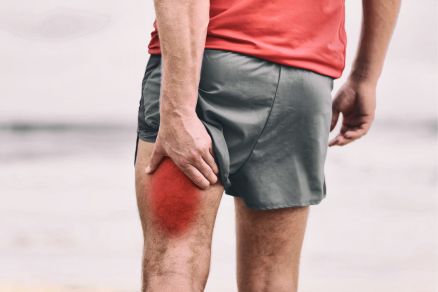Spondyloarthritis is a group of inflammatory rheumatologic conditions that primarily affect the spine and sacroiliac joints of the pelvis. The name comes from “spondyl,” referring to the spine’s vertebrae, and “itis,” denoting inflammation. Spondyloarthritis also can involve peripheral joints, tendon insertions, and extra-articular structures. This category encompasses several distinct disorders with clinical features and genetic risk factors. The most prevalent types of spondyloarthritis are ankylosing spondylitis, psoriatic arthritis, reactive arthritis, and arthritis associated with inflammatory bowel disease.
Epidemiology of Spondyloarthritis
Spondyloarthritis has varying prevalence estimates globally depending on the subtype and population studied. It affects between 0.2% to 1.9% of the worldwide population. Ankylosing spondylitis impacts between 0.1% and 1.8% of people across different geographic regions. Prevalence is ten times higher among first-degree relatives, underscoring the genetic underpinnings. Spondyloarthritis onset occurs most commonly in the third decade of life, with the vast majority developing symptoms before age 45. It affects males more frequently, with a male-to-female ratio approximating 2:1. White individuals are more often affected than black individuals. Certain subtypes strongly associate with genetic markers like the HLA-B27 allele in 90% of ankylosing spondylitis cases.
Pathogenesis of Spondyloarthritis
The underlying cause of spondyloarthritis involves a complex interaction between genetic susceptibility and environmental factors. There are nearly 100 identified gene polymorphisms associated with increased disease risk. The strongest genetic link is with the HLA-B27 allele, present in up to 95% of ankylosing spondylitis patients compared to only 8% of the general population. However, inheritance of HLA-B27 alone is insufficient to trigger spondyloarthritis’s onset. Other genes regulating innate immunity, cytokine signaling, and tissue remodeling also play a role.
Environmental factors are thought to incite the activation of inflammatory pathways in genetically susceptible individuals. Intestinal microbes likely drive mucosal immune responses that ignite joint inflammation in those with predisposing genes. This helps explain the strong association between spondyloarthritis and inflammatory bowel diseases like Crohn’s and ulcerative colitis through common intestinal immune system involvement. Bacterial infections are implicated as triggers in reactive arthritis subtypes as well. Biomechanical factors affecting the spine and SI joints also contribute to ankylosing spondylitis. Physical trauma and skin manifestations promote peripheral joint inflammation in psoriatic arthritis.
Overall, the pathogenesis of spondyloarthritis involves complex interactions between intestinal microbes, mucosal immunity, and epithelial integrity in those with genetic vulnerability. This leads to inappropriate inflammatory cytokine signaling, including IL-23 and IL-17 mediated pathways. The resulting chronic inflammation drives the enthesitis, synovitis, and osteitis underlying progressive joint destruction and disability.
Symptoms and Signs of Spondyloarthritis
Despite some differences, the various spondyloarthritis diseases share certain common clinical features:
- Asymmetric lower limb oligoarthritis – Knees and ankles are most often affected
- Enthesitis – Inflammation where tendons and ligaments attach to bone
- Dactylitis – Sausage-like swelling of entire digits
- Inflammation of ligamentous joint capsule insertions
- Heel pain and plantar fasciitis – Common early manifestation
- Iritis and uveitis – Eye inflammation is more common than in other arthritis
- Psoriasis, inflammatory bowel disease, or family history in a first-degree relative
- Onset generally before age 45 and predominance in males
- Symptoms improve with activity and worsen with rest
- Limited spinal mobility and chest expansion
These shared clinical features reflect common immunopathogenesis mechanisms, including IL-23-mediated inflammation. However, specific spondyloarthritis diseases have some distinguishing characteristics.
Ankylosing Spondylitis
Ankylosing spondylitis is the most common subtype, accounting for the majority of spondyloarthritis cases. It primarily affects the spine and sacroiliac joints in the pelvis. Symptoms typically begin between ages 20-30, with insidious lower back pain and morning stiffness improving with activity and worsening with rest. Pain and stiffness gradually ascend up the spine from the lower back. A physical exam reveals limited spinal flexion and chest expansion. Peripheral manifestations can include hip arthritis, anterior uveitis, aortic regurgitation, cauda equina syndrome, and osteoporosis. Radiographs classically show squaring of the vertebrae, syndesmophytes, and bilateral sacroiliitis. Spinal fusion can occur without treatment due to chronic inflammation and pathological new bone formation.
Psoriatic Arthritis
Psoriatic arthritis occurs in up to 30% of psoriasis patients, usually following skin disease onset. It often affects the distal interphalangeal joints, fingers, and toes symmetrically. Sausage digits and nail pitting are characteristic findings. Any pattern of joint involvement can occur. Spinal disease is less common than in ankylosing spondylitis. Enthesitis and dactylitis are typical extra-articular features. Psoriasis skin lesions facilitate diagnosis. X-rays reveal the proliferation of bone at the distal phalanges along with joint space loss.
Reactive Arthritis
Reactive arthritis results from an immune reaction following infection with specific bacteria, especially chlamydia, salmonella, shigella, or yersinia. It involves inflammation of joints, eyes, and the urogenital tract after infection at a distant mucosal site. The arthritis is typically asymmetric and additive, preferentially affecting the knees and ankles. Enthesitis and sacroiliitis may occur as well. Mucocutaneous lesions, oral ulcers, and balanitis circinata reflect immune cross-reactivity. It usually resolves within 3-12 months without joint damage.
Arthritis Associated with Inflammatory Bowel Disease
Arthritis occurs in up to 25% of inflammatory bowel disease patients, including peripheral arthritis and sacroiliitis. It can precede bowel symptoms but often coincides with Crohn’s or ulcerative colitis flares. Axial disease manifestations are similar to ankylosing spondylitis. Treatment targets both musculoskeletal inflammation and intestinal disease activity.
Undifferentiated Spondyloarthritis
Some patients have clinical features consistent with spondyloarthritis but do not meet the criteria for a specific subtype. This is termed undifferentiated spondyloarthritis, often representing early or mild disease. These patients require close monitoring for progression to definite spondyloarthritis. It may also include overlap forms not fitting one exact disease category.
Diagnosing Spondyloarthritis
There is no single diagnostic test for spondyloarthritis. Diagnosis relies on clinical judgment based on a combination of patient history, physical exam findings, imaging, and lab work. Key aspects in making the diagnosis include:
- Pattern of joint involvement – Lower limb oligoarthritis and enthesitis
- Extra-articular features – Uveitis, inflammatory bowel disease, psoriasis
- Demographics – Onset in early adulthood, male predominance
- Symptoms improving with activity – Characteristic of spondyloarthritis
- Family history – Higher prevalence in first-degree relatives
- Imaging evidence – X-rays showing sacroiliitis and syndesmophytes
- Lab findings – HLA-B27, elevated CRP and ESR
- Response to NSAIDs – Excellent therapeutic response
Early diagnosis is critical to prevent irreversible damage, though milder forms can be challenging to recognize before progression. A thorough history, physical exam, imaging, and sometimes a treatment trial are required to diagnose potential spondyloarthritis subtypes confidently.
Lab Testing and Imaging for Spondyloarthritis Diagnosis
While no single lab or imaging test confirms spondyloarthritis, certain findings provide supportive diagnostic evidence:
- HLA-B27 genetic marker – Positive in 90% of ankylosing spondylitis patients
- Erythrocyte sedimentation rate (ESR) – Markers of systemic inflammation
- C-reactive protein (CRP) – Elevated in active spondyloarthritis
- Complete blood count – Anemia of chronic disease, thrombocytosis
- Kidney and liver function tests – Monitor for medication toxicity
- Plain radiography – Reveals sacroiliitis, syndesmophytes, squaring, and proliferative changes
- MRI – Detects acute inflammation and structural lesions
- CT scan – Useful for assessing bony changes and fractures
- Ultrasound – Identifies enthesitis and guides joint injections
While some findings are more specific, no test result definitively confirms or excludes spondyloarthritis. The full clinical, laboratory, and imaging picture must be considered to make an accurate diagnosis.
Treatment for Spondyloarthritis
Many effective medications are available to manage spondyloarthritis symptoms, slow disease progression, and prevent permanent impairments:
- NSAIDs – First-line treatment for pain and inflammation. Indomethacin and celecoxib are most effective.
- TNF alpha inhibitors – Adalimumab, etanercept, and infliximab- are used for severe axial disease unresponsive to NSAIDs.
- IL-17 inhibitors – Secukinumab and ixekizumab target IL-17-mediated inflammation. Helpful for those not responding to TNF inhibitors.
- DMARDs – Methotrexate, sulfasalazine, and leflunomide help suppress peripheral joint disease.
- Biologics – Ustekinumab, apremilast, and tofacitinib provide alternate therapy options targeting IL-23, PDE4, and JAK pathways.
- Local steroid injections – Directly into inflamed joints or entheses to provide a local anti-inflammatory effect.
- Physical Therapy – Stretches, exercises, and postural training help maintain mobility and function.
- Spinal braces – Support and stabilize the spine to reduce pain.
- Surgery – Rarely required for severe structural damage not amenable to conservative measures.
The goal is achieving disease remission and preventing disease progression that could lead to joint destruction and disability. Medications aim to control inflammation, relieve symptoms, restore function, and improve quality of life. Early intensive treatment within the first few years offers the best outcomes. Non-pharmacologic approaches like physiotherapy have an important adjunctive role as well.
Treating Peripheral Arthritis in Spondyloarthritis
While axial disease is the hallmark of spondyloarthritis, peripheral arthritis also frequently occurs. The knees, ankles, hips, shoulders, and wrists can be affected, often in an asymmetric distribution. Physical exam typically reveals swelling, pain, and limited mobility of the involved joints. Plain radiographs may show osteopenia, erosions, or proliferation in affected joints. MRI can identify active synovitis and bone marrow edema.
First-line treatment for peripheral arthritis involves NSAIDs and intraarticular steroid injections into actively inflamed joints. DMARDs like sulfasalazine and methotrexate can be added for persistent oligoarthritis unresponsive to NSAIDs alone. Worsening polyarthritis may require advanced therapy with TNF inhibitors or other biologics that also address the axial components. Occupational therapy can help maintain hand and wrist function. Surgery is rarely indicated for damaged joints. The key is controlling inflammation to prevent cumulative joint destruction.
Spondyloarthritis and Enthesitis
Enthesitis is inflammation where tendons, ligaments, or joint capsules attach to bone. The entheses are frequent early targets of inflammation in spondyloarthritis. Common sites of enthesitis include the Achilles tendon, plantar fascia, knee ligaments, and spinal ligaments. Enthesitis clinically manifests as pain and tenderness at the insertion points, often preceding overt synovitis.
Treatment focuses on relieving inflammation at the enthesis. Local corticosteroid injections can provide marked symptom relief. Systemic NSAIDs help control overall disease activity and inflammation. Physical therapy aims to maintain flexibility through stretching and range of motion exercises. TNF inhibitors may be required for severe, refractory cases not responsive to local injections. Once the underlying spondyloarthritis is adequately controlled, the symptomatic enthesitis generally improves.
Managing Axial Spondyloarthritis
Axial spondyloarthritis primarily affects the spine and sacroiliac joints. Symptoms involve lower back pain and morning stiffness that improve with activity. It typically begins in the lower back before progressing up the spine. Restricted spinal mobility and chest expansion are characteristic. Without treatment, it can progress to complete spinal fusion and loss of mobility. MRI reveals active inflammation and structural lesions.
Axial disease management requires controlling inflammation and preventing disease progression. First-line treatment includes NSAIDs and physiotherapy exercises to maintain chest and spine mobility. Regular home stretching is also essential. TNF alpha inhibitors like etanercept, adalimumab, or infliximab can be highly effective if NSAID treatment fails for severe, active disease. Rarely, spinal braces or surgery may be required for deformities, fractures, or severe loss of mobility. The key is early diagnosis and optimal treatment to prevent disabling spinal fusion.
Ankylosing Spondylitis
Ankylosing spondylitis is the prototypical form of spondyloarthritis, accounting for most cases. It is characterized by chronic inflammation of the sacroiliac joints and spine. Symptoms typically begin in early adulthood with lower back pain and stiffness that improve with activity and worsen with rest. Pain and stiffness gradually ascend the spine. Eventually, bony fusion can occur due to pathological new bone formation.
Diagnosis is based on characteristic X-ray findings of sacroiliitis and syndesmophytes and supportive clinical features. A physical exam reveals decreased spinal mobility and chest expansion. HLA-B27 genetic marker testing is positive in over 90% of cases. Extra-articular manifestations can include anterior uveitis, aortitis, and pulmonary fibrosis. Without adequate treatment, progressive spinal fusion leads to loss of mobility and profound disability. The goals of therapy are controlling inflammation, maintaining posture and mobility, and preventing fusion.
Psoriatic Arthritis
Psoriatic arthritis occurs in up to 30% of psoriasis patients, typically following the skin disease. Distal interphalangeal joints, fingers, and toes are more often affected than in other spondyloarthritis subtypes. Nail changes like pitting and onycholysis are characteristic. Any pattern of joint involvement can occur. Dactylitis and enthesitis are common extra-articular features. Spinal disease is less frequent compared to ankylosing spondylitis. Psoriasis skin findings help facilitate diagnosis. X-rays classically reveal proliferative changes in the distal phalanges and joint space narrowing. Psoriasis and the musculoskeletal disease manifestations should be treated to control the disease fully.
Reactive Arthritis
Reactive arthritis results from an immune reaction following infection with certain bacteria, especially chlamydia, salmonella, shigella, or yersinia. It generally occurs within 1-4 weeks of the inciting infection. Manifestations include arthritis predominately affecting the knees and ankles, conjunctivitis, and urethritis. Rash, oral ulcers, and circinate balanitis reflect immune cross-reactivity. Reactive arthritis typically resolves spontaneously within 3-12 months without joint destruction. NSAIDs, intraarticular steroid injections, and physiotherapy help manage symptoms during acute flares. Antibiotics are not beneficial unless active infection is proven. Most patients regain normal joint function without long-term impairments.
Arthritis Associated with Inflammatory Bowel Disease
Arthritis occurs in up to 25% of inflammatory bowel disease patients, including peripheral arthritis and axial sacroiliitis resembling ankylosing spondylitis. Joint symptoms may precede bowel inflammation but often run in parallel with IBD activity. Arthritis management requires controlling both bowel and joint inflammation. TNF inhibitors that decrease musculoskeletal and intestinal inflammation are often optimal therapy. Tight control of IBD disease activity helps prevent associated arthritis flares.
Spondyloarthritis Prevention and Disease Modification
While the root causes of spondyloarthritis remain unknown, certain prevention strategies may help decrease symptoms and slow progression:
- Regular exercise – Light stretching, posture training, and aerobics promote mobility.
- Activity pacing – Alternating rest and activity avoids overexertion.
- Weight control – Reducing obesity minimizes joint stress.
- Smoking cessation – Eliminating smoking lowers disease activity.
- Proper body mechanics – Maintaining good posture and alignment.
- Assistive devices – Canes, raised toilet seats, and grab bars minimize joint strain.
- Physical therapy – Targeted exercises strengthen stabilizing muscles around joints.
- NSAIDs – Anti-inflammatories help control symptoms and progression.
- Biologics – Powerful immunomodulating medications prevent joint damage.
While spondyloarthritis cannot be prevented definitively, progression can be slowed by adhering to treatment regimens, staying active within limits, and promptly managing flares. Patient education, lifestyle modifications, medications, exercise, and self-management skills help those with spondyloarthritis live full, active lives and reduce the risk of long-term disability.
Research and Emerging Treatments for Spondyloarthritis
While current treatments for spondyloarthritis can effectively control symptoms and slow disease in many patients, there remains no cure. Ongoing research aims to understand spondyloarthritis pathogenesis better and identify potential therapeutic targets. Areas of active investigation include:
- Gut microbiome connections – Manipulating intestinal flora may influence spondyloarthritis. Fecal transplants are being explored.
- Biomarkers – Identifying biomarkers could facilitate early diagnosis and predict treatment responses.
- Genetics – Gene sequencing may reveal new risk alleles and genetic testing applications.
- Imaging – Advancing MRI and ultrasound could improve diagnosis and monitoring.
- Targeted biologics – Novel monoclonal antibodies targeting IL-17, IL-23, and TNF pathways show promise.
- Small molecules – Janus kinase (JAK) inhibitors like tofacitinib are being evaluated as treatment options.
- Disease modification – Halting progression to permanent joint damage is a key goal.
- Lifestyle factors – Studying dietary impacts, smoking
Lifestyle Factors and Spondyloarthritis
Along with medications, certain lifestyle factors may influence spondyloarthritis disease activity and progression:
Diet
- Omega-3 fatty acids – Found in fish oils, may have anti-inflammatory effects
- Probiotics – Can positively alter gut microbiome implicated in disease
- Limiting refined carbohydrates – Higher intake is associated with greater disease activity
- Avoiding gluten – May improve symptoms in some patients
- Maintaining ideal weight – Obesity linked to higher disease activity
Exercise
- Aerobic exercise – Improves cardiovascular health and helps maintain mobility.
- Stretching and yoga – Preserve flexibility and range of motion
- Posture training – Corrects spine alignment and strengthens core muscles
- Water therapy – Buoyancy minimizes stress on joints
Other Factors
- Smoking cessation – Eliminating smoking has been shown to decrease symptoms.
- Stress management – Managing anxiety and depression may lower disease activity.
- Hot/cold therapy – Local application of heat or ice to affected joints
- Massage – May help relaxation and release tight muscles
- Acupuncture – May offer symptomatic relief in some patients
Encourage patients to explore complementary lifestyle approaches that can enhance conventional medical therapy. However, unproven remedies should not replace or delay science-based treatment. A balanced integrative approach tailored to the individual offers optimal spondyloarthritis management.
Spondylitis Association of America
The Spondylitis Association of America (SAA) is a non-profit patient advocacy organization focused on ankylosing spondylitis and related spondyloarthritis diseases. The mission of SAA includes:
- Providing education to improve public awareness of spondyloarthritis
- Supporting research to better understand disease mechanisms
- Advocating to improve access to treatments and quality of life
- Facilitating connections between patients, caregivers, and health providers
- Representing the interests of spondyloarthritis patients
SAA offers online resources covering diet, exercise, medications, and lifestyle tips to help spondyloarthritis patients manage their disease and live fuller lives. Through local seminars and national conferences, SAA also brings medical experts together with patients to share the latest information on spondyloarthritis research and care. Support groups foster connections between patients coping with the physical and emotional challenges of living with spondyloarthritis. By promoting greater public awareness and encouraging research, SAA gives patients the knowledge, tools, and community support needed to overcome daily obstacles and live well.
Juvenile Spondyloarthritis
Juvenile spondyloarthritis refers to the onset of spondyloarthritis symptoms in children younger than 16 years old. It often has a genetic component, with many having a first-degree relative with spondyloarthritis. The average age of onset is 11-12 years old. Symptoms resemble adult spondyloarthritis but with less axial involvement and more peripheral arthritis, enthesitis, and acute anterior uveitis. Juvenile spondyloarthritis can impair growth and bone development. Diagnosis is challenging given non-specific symptoms and lack of HLA-B27 and radiographic findings early on. Treatment includes NSAIDs, physical therapy, DMARDs, and biologics in severe cases. Ensuring proper management in pediatric patients is essential to prevent complications in development.
Spondyloarthritis: Key Takeaways
Spondyloarthritis represents a spectrum of inflammatory arthritides sharing clinical features but also some distinct characteristics. Genetic susceptibility coupled with environmental triggers leads to immune-mediated inflammation preferentially targeting the spine, sacroiliac joints, entheses, and asymmetric joints of the lower limbs. While spondyloarthritis tends to run in families and occur in young adults, early diagnosis remains challenging.
Expert clinical judgment coupled with imaging and lab findings helps differentiate between potential spondyloarthritis subtypes and guide appropriate treatment. Modern disease-modifying medications have greatly improved the management of symptoms, progression, and quality of life. The goals of therapy are controlling inflammation, restoring function, preventing deformity, and improving patient education and self-management skills. With early optimal treatment, most patients achieve good control of symptoms and are able to remain productive members of society. Increased awareness and understanding of spondyloarthritis among medical providers and the public facilitates earlier intervention and better long-term outcomes.
FAQs
Yes, it is possible for spondyloarthritis to go through periods of almost complete remission where symptoms resolve, typically when inflammation is well-controlled through medications and lifestyle factors. However, symptoms often return or flare up again rather than being a permanent remission.
The speed of progression varies greatly among patients. Modern treatments aim to control inflammation and prevent further progression. Caught early and managed optimally, many patients live full lives with minimal disability, though symptoms fluctuate over time.
Severe, uncontrolled spondyloarthritis can potentially lead to joint damage and spine fusions, resulting in disability. However, today, most cases can be managed well enough to continue working and staying active, especially if treated early.
Yes, spondyloarthritis can rarely occur in children under age 17, which is called juvenile spondyloarthritis. Symptoms may present differently than adult-onset disease.
There is no evidence that cracking or popping your back is beneficial for spondyloarthritis pain. Stretching exercises under a physical therapist’s guidance are safer ways to help relieve stiffness.
Cold packs may provide short-term relief for flare-ups while warm compresses and baths can help ease chronic stiffness. Alternating heat and ice therapy is generally recommended for pain management.
Many patients report their spondyloarthritis symptoms worsen with cold, damp weather. Barometric pressure changes may play a role. Staying warm and dressing appropriately can help.
Yes, spondyloarthritis is a form of inflammatory arthritis because it involves immune-mediated inflammation, causing joint pain and damage. Other types of arthritis include rheumatoid arthritis, psoriatic arthritis, and osteoarthritis.
Yes, inflammation of the eyes, called uveitis, can be associated with spondyloarthritis. Eye pain, redness, blurry vision, or sensitivity to light should be evaluated promptly.
Certain medications used to treat spondyloarthritis affect the immune system and may increase susceptibility to infections. Proper hygiene and handwashing are important preventative measures.

Chris Hanks is an experienced physical therapist based in Austin, Texas. He earned his Doctor of Physical Therapy degree from the University of Texas at Austin in 2005 after completing his Bachelor of Science in Kinesiology in 2002. Dr. Hanks has been a licensed PT in Texas since 2005. He began his career at Central Texas Rehabilitation Hospital before moving to Austin Sports Medicine Center in 2010. In 2015, Dr. Hanks opened his own clinic, Capital City Physical Therapy, where he continues to treat patients.






